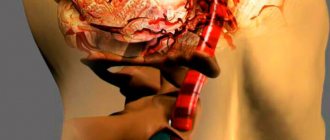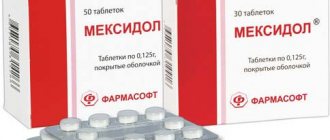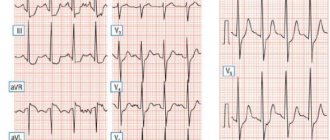| Intracranial hypertension | |
| MRI image of the brain of a person with intracranial hypertension | |
| ICD-10 | 93.293.2 |
| ICD-9 | 348.2348.2 |
| OMIM | 243200 |
| DiseasesDB | 1331 |
| MedlinePlus | 000351 |
| eMedicine | neuro/329 oph/190oph/190 neuro/537neuro/537 |
| MeSH | D011559 |
Intracranial hypertension (ICH)
(ancient Greek ὑπερ- - super- + lat. tensio - tension) - increased pressure in the cranial cavity. May be caused by brain pathology (traumatic brain injury, tumors, intracranial hemorrhage, encephalomeningitis, etc.). It occurs as a result of an increase in the volume of intracranial contents: cerebrospinal fluid (CSF), tissue fluid (cerebral edema), blood (venous stagnation) or the appearance of foreign tissue (for example, with a brain tumor).
Epidemiology
For work[1]
The most common cause of intracranial hypertension is head trauma.
The most common solid neoplasm is a brain tumor. It is often the cause of intracranial hypertension, either as a direct mass effect or by blocking the flow of cerebrospinal fluid. Ischemic brain damage resulting from difficulties during childbirth, drowning, and cerebral thrombosis can also cause intracranial hypertension. More rare causes are cytotoxic swelling of the brain (lead poisoning, liver failure in Reye's syndrome).
Benign intracranial hypertension (idiopathic intracranial hypertension, pseudotumor cerebri) can also lead to increased intracranial pressure. It is often observed in overweight adolescent girls, but can also occur with venous sinus thrombosis caused by bleeding diathesis or complicated otitis media or mastoiditis, accompanied by high doses of vitamin A or tetracycline, or withdrawal of steroid therapy.
Idiopathic intracranial hypertension
Idiopathic intracranial hypertension (IIH), also known as pseudotumor cerebri , is a syndrome with symptoms of increased intracranial pressure in the absence of a mass lesion or hydrocephalus. Translation [22].
Terminology
The outdated term benign intracranial hypertension is undesirable for the reason that in some cases this syndrome is characterized by an aggressive clinical picture and progressive loss of vision.
Interestingly, as evidence emerges that patients with idiopathic intracranial hypertension have venous sinus stenosis, some authors are now advocating a return to the older term pseudotumor cerebri because the intracranial hypertension is not idiopathic. An alternative solution to this issue is to transfer such patients to the group of patients with secondary intracranial hypertension [15].
Epidemiology
IIH most commonly affects obese middle-aged women, although the etiological relationship between female obesity and IIH remains to be elucidated. This syndrome is less common in men (usually elderly), and even less common in obese men [15]. IIH is extremely rare among children [15].
Clinical picture
The most common symptoms are headaches, visual disturbances (transient or progressive vision loss), pulse-synchronous tinnitus, photopsia and ocular pain [15].
Papilledema is not always common; may be unilateral (including pseudo-Foster-Kennedy syndrome), which makes the final diagnosis less clear [6]. On neurological examination, there may be palsy of the 6th pair of cranial nerves.
An additional clinical sign is the normal composition of the cerebrospinal fluid with increased initial pressure. It is worth noting that the values of increased initial pressure vary widely.
Thus, according to one study, the average pressure was less than 35 mm. rt. Art. (48 cm water column), while there were episodes of pressure increase to 50-80 mm Hg. Art. (68-109 cm aq.
st) for 5-20 minutes [6].
Meningocele with secondary leakage of cerebrospinal fluid can manifest as rhinorrhea, otorrhea and recurrent bacterial meningitis [7,9]. In such patients, IIH often manifests itself only after restoration of the dura mater, which is apparently associated with normalization of intracranial pressure during cerebrospinal fluid leakage [9].
Pathology
The etiopathogenesis of IIH is not fully understood. It is assumed that various mechanisms are involved in the development of this syndrome - decreased absorption of cerebrospinal fluid, increased production of cerebrospinal fluid, increased intravascular volume, increased intracranial venous pressure and hormonal disorders [1,15].
Relationship with other pathologies
IIH is associated with such pathologies as:
- endocrine diseases adrenal insufficiency
- Cushing's disease
- hypoparathyroidism
- hypothyroidism
- excessive intake of thyroxine in children
CT/MRI
Carrying out a CT or MRI of the brain in patients with IIH is a mandatory diagnostic step to exclude causes of increased intracranial pressure such as brain tumors, thrombosis of the venous sinuses, hydrocephalus, etc.
In the absence of causes of intracranial hypertension, there are a number of radiological signs that speak in favor of IIH [3, 6 – 9, 15]:
- optic nerves significant expansion of the subarachnoid spaces of the nerves (45%)
- vertical tortuosity of the optic nerves (40%)
- swelling of the optic disc, flattening of the posterior pole of the sclera (80%)
- intraocular protrusion of the optic nerve head
- empty sella turcica (70%)
- lateral segments of the transverse sinuses
If bone changes are permanent, then the rest are dynamic and reversible with treatment [3].
It is very important to take into account the age and gender of patients when assessing the identified changes, since in the elderly, especially in men, an “empty” sella turcica in some cases may be a variant of the age norm.
Treatment and prognosis
Treatment for IIH includes lumbar puncture, diuretics (acetazolamide), and lumboperitoneal shunting. In patients with progressive vision loss, optic nerve sheath excision is performed.
Venous sinus stenting has already been used in a number of cases and is currently undergoing clinical trials [13, 14]. However, this issue is controversial, since it is necessary to determine whether stenosis is a cause or a consequence of IIH [11,12]. There is also evidence of spontaneous resolution of stenosis [6].
History and etymology
IIH was first described in 1893 by Heinrich Quincke as “meningitis serosa.” The term “pseudotumor cerebri” was introduced later than 1904, and in 1955 it was called “benign idiopathic hypertension” (not to be confused with benign intracranial hypotension) [15].
Pathogenesis
The skull and dura mater form a rigid frame, so the cranial cavity has a constant volume and, accordingly, the sum of the volumes of its elements is constant:
Vbrain tissue + Vcerebrospinal fluid + Vblood = Const Vbrain tissue = Vintracellular environment + Vextracellular environment
Any increase in one of the three components of intracranial volume - brain parenchyma, cerebrospinal fluid, blood - leads to a decrease in the other one or two components and an increase in pressure in the cranial cavity. Irreversible damage to brain tissue occurs more often as a result of pressure from other components exceeding arterial blood pressure, resulting in insufficient perfusion of brain tissue. Open sutures of the skull of young children make it possible to smooth out the increase in the volume of components, but this smoothing is impossible with an acute increase in volume. Pressure drops can also occur in certain areas of the intracranial volume, areas of cerebrospinal fluid flow, or around the focus of pathological changes in the brain parenchyma.
Changes in components of intracranial volume lead to increased intracranial pressure in several ways. Firstly
, the brain parenchyma itself can increase by a mass associated with a pathological change - neoplasm, abscess, hemorrhage. Vasogenic edema can increase brain parenchyma through extravasation due to cytokines. Cerebral edema may also result from cytotoxic injury, cell death and necrosis, which leads to increased interstitial pressure from released proteins and ions, as well as inflammatory and repair processes. The immediate cause may be mediated by hypoxemia; intermediate metabolic toxins, including neuronal excitotoxins; depletion of energy sources resulting from thrombus formation in the great vessels, contusion or diffuse axonal damage, anoxia from cardiac arrest, hypertensive encephalopathy, encephalitis infection, metabolic poisoning. Edema following head trauma is greater in children than in adults and may be a combination of vasogenic and cytotoxic edema, as well as neurogenic inflammatory release of substance P and cocalcigenin at the molecular level.
Secondly
, the pressure of such a component as the flow of cerebrospinal fluid (ventricles or subarachnoid space) may increase with hydrocephalus. Hydrocephalus can have the following consequences: a discrepancy in the level of formation of the cerebrospinal fluid flow relative to absorption and obstruction between the site of formation in the lateral ventricles and the sites of absorption in the arachnoid granulation. The causes of obstruction may be a congenital defect; parenchymal or intraventricular mass (cyst or neoplasm); inflammatory infiltrate cells in the cerebrospinal fluid stream from meningitis, ventriculitis or hemorrhage; subarachnoid proteins or remains of organic substances; brain dislocation; Excessive growth of dural tissue. Particularly vulnerable to obstruction are the small tubules connecting the ventricular system, the interventricular foramen, and the aqueduct of Sylvius; exits of the ventricular system, lateral foramen of the fourth ventricle (foramen of Magendie) and lateral foramen; cisterns surrounding the brainstem. Another type of cerebral edema, interstitial edema is characterized by periventricular extravasation of the cerebrospinal fluid flow into the adjacent white matter. This swelling is usually observed in patients with acute or subacute hydrocephalus.
Third
, intracranial pressure may increase due to increased intravascular volume. This occurs when the venous outflow is obstructed, for example, due to thrombosis of the dural sinuses. Many cases of intracranial pressure of unknown origin are associated with stenosis or thrombosis of the transverse dural sinus. Other processes that increase jugular venous pressure may also increase intracranial pressure. Also, intracranial vascular arterial volume is affected by the partial pressure of carbon dioxide. Vascular volume can either increase with hypercapnia or decrease with hypocapnia, which occurs with central neurogenic hyperventilation or an iatrogenic decrease in intracranial pressure through mechanical hyperventilation.
Intracranial pressure is often measured in centimeters of water cmH2O, while blood pressure is measured in mmHg. The normal level of intracranial pressure during childhood and infancy is approximately 6 cmH2O (5 mm Hg); in adolescents, a value above 25 cmH2O (18 mmHg) is not normal and causes symptoms. At the same time, it is possible to maintain normal cognitive functions at a pressure of 52 cmH2O (40 mmHg), which assumes the adequacy of the perfusion pressure. Therefore, it is important to know not the absolute values of intracranial pressure, but the values of intracranial pressure relative to arterial mean pressure. Increased intracranial pressure acquires clinical manifestations when there is an abnormality in perfusion pressure, which occurs when the intracranial pressure is 78 cmH2O (60 mmHg) below the arterial mean pressure and becomes threatening when the intracranial pressure is only 52 cmH2O lower than the arterial mean pressure ( 40 mm Hg) Reduced perfusion produces swollen damaged tissue, which increases the volume of brain parenchymal tissue and thus further exacerbates pressure increases due to volume growth.
With an increase in intracranial pressure, cerebral perfusion can be maintained by a temporary spontaneous increase in arterial mean pressure - the Cushing reflex (hypertension along with bradycardia and bradypnea). Although this association is not necessary, given other features, increased systemic pressure is a clinical sign of intracranial hypertension. In the normal state, changes in arterial cerebrovascular resistance are associated with changes in perfusion pressure to maintain constant cerebral blood flow - a process called autoregulation. However, with a head injury or asphyxia, this process is disrupted.
When intracranial pressure increases in one of the areas of the skull, an area of distension occurs, which leads to a displacement of brain structures relative to each other - dislocation syndromes develop. This pathology is life-threatening and can lead to the death of the patient. A threatening harbinger of transtentorial herniation of the temporal lobe hook is the loss of the papillary reflex to light due to entrapment of the oculomotor nerve. Dislocation often leads to irreversible damage to the brain stem, heart attacks, and additional secondary edema, which can lead to brain death. A focal increase in pressure in the posterior fossa can result in a cone of pressure acting downward through the foramen magnum, compressing the centers of the spinal cord, which can also lead to apnea and brain death. The compensatory system can be decompensated by an erroneous lumbar puncture, in which the pressure within the spinal canal is sharply reduced, increasing the pressure gradient through the foramen magnum, which leads to brain dislocation.
The most common dislocation syndromes are:
- displacement of the cerebral hemispheres under the falx process,
- temporotentorial displacement,
- cerebellar-tentorial displacement,
- displacement of the cerebellar tonsils in the foramen magnum.
When the cerebrospinal fluid pressure increases to 400 mm water. Art. (about 30 mm Hg), cerebral circulation and cessation of bioelectrical activity of the brain are possible.
Read also
Gliomas
What is a glioma?
Glioma is a neuroepithelial tumor, a type of tumor of the central nervous system, the source of growth of which is glial tissue. In turn, glial tissue (glia)… Read more
Aphasia
Aphasias are speech defects that appear with minor brain damage, most often affecting the left hemisphere in right-handed people, and consisting of various forms of speech changes. Location and size...
More details
Syringomyelia
Syringomyelia is a disease caused by the formation of spaces in the substance of the spinal cord filled with cerebrospinal fluid. They expand the spinal cord at the level of the lower cervical and thoracic regions...
More details
Clubfoot
Clubfoot should not be understood as just one foot disorder. This is a group of deformities of the foot and ankle joint with their pathological setting. Clubfoot is a deformity in which...
More details
Chiari malformation
What is Chiari Malformation? Chiari malformation (formerly Arnold-Chiari malformation) is a congenital defect of brain development that involves the dislocation of the cerebellar tonsils into the spinal canal through the large…
More details
Clinical picture
The formation of clinical hypertension syndrome and the nature of its manifestations depend on the localization of the pathological process, its prevalence and speed of development.
Clinically, ICH syndrome is manifested by headaches of increased frequency or severity (increasing headaches), sometimes awakening from sleep, often forced head position, nausea, and repeated vomiting. Headache can be complicated by cough, painful urge to urinate and defecate, and actions similar to the Valsalva maneuver. Possible disturbances of consciousness and convulsive seizures. With prolonged existence, visual impairment occurs.
History may include trauma, ischemia, meningitis, cerebrospinal fluid shunt, lead intoxication or metabolic disorder (Reye's syndrome, diabetic ketoacidosis). Newborns with cerebral ventricular hemorrhage or meningomyelocele are predisposed to intracranial hydrocephalus. Children with blue heart disease are predisposed to an abscess, and children with sickle cell disease may have a stroke leading to intracranial hypertension.
Objective signs of intracranial hypertension are swelling of the optic disc, increased cerebrospinal fluid pressure, increased osmotic pressure of the extremities, and typical x-ray changes in the bones of the skull. It should be borne in mind that these signs do not appear immediately, but after a long time (except for increased cerebrospinal fluid pressure).
There are also signs such as:
- loss of appetite, nausea, vomiting, headache, drowsiness;
- inattention, decreased ability to awaken;
- papilledema, upward gaze paresis;
- increased tone, positive Babinski reflex;
With a significant increase in intracranial pressure, disturbances of consciousness, convulsive attacks, and visceral-vegetative changes are possible. With dislocation and herniation of brain stem structures, bradycardia, respiratory failure occur, pupillary response to light decreases or disappears, and systemic blood pressure increases.
Treatment of increased intracranial pressure
Therapy for increased intracranial pressure can be carried out using both conservative and surgical methods. When intracranial hypertension develops, treatment should be carried out under the supervision of the attending physician. For chronic or benign intracranial hypertension, when there are no obvious signs of progression of the pathological process, drug treatment is usually prescribed.
If a slight increase in pressure is detected, strictly dosed use of diuretics can solve the problem. The attending physician selects medications depending on the severity of the pathological process. Commonly used drugs that have a diuretic effect are:
- Diacarb.
- Veroshpiron.
- Lasix.
- Hypothiazide.
In most cases, diuretics are prescribed in combination with potassium preparations, for example, potassium chloride or Asparkam. This can significantly reduce the negative consequences of taking diuretics. In addition, with a conservative approach to the treatment of intracranial pressure, medications are prescribed to eliminate the root cause of the problem.
If there is idiopathic intracranial hypertension, a special low-calorie diet and feasible physical activity may be indicated to normalize body weight. To maintain the functioning of nerve fibers in conditions of their loss, drugs with neurometabolic action can be prescribed. Throughout the acute period of increased intracranial pressure, patients are advised to avoid physical and emotional stress, as well as limit time spent working at the computer, and avoid reading and listening to music through headphones. Reducing the load on the organs of vision and hearing will significantly reduce the duration of the acute period.
Surgical treatment of increased intracranial pressure can be performed either as an emergency or planned procedure. The option of surgical intervention depends on the characteristics of the development of the pathological condition. Typically, emergency operations are performed when there is a risk of herniation of brain structures or disruption of brain function due to a critical increase in intracranial pressure. Such surgical intervention helps prevent the development of dislocation syndrome. In such emergency situations, decompressed craniotomy or external ventricular drainage is usually performed.
Planned operations are carried out if space-occupying formations have been detected in the brain structures. In addition, such interventions are necessary to correct a number of congenital anomalies, eliminate hydrocephalus through cerebral shunting and some other problems.
Differential diagnosis
Migraine, epilepsy, and metabolic disorders have a clinical picture similar to intracranial hypertension. If a child has focal neurological signs along with general symptoms of ICH, imaging can rule out a neoplasm and confirm the safety of a lumbar puncture. Subsequent measurement by lumbar puncture manometry, once normal pressure is established, will establish hemicrania.
If the child is only partially responsive, the task of distinguishing seizures of epilepsy or the post-seizure state from conditions that lead to ICH may be difficult. Factors that give reason to assume convulsive attacks of epilepsy are cyclicity; clonic convulsion; sudden muscle movement; rapid or variable change in tone, a posture that differs from the decerebrate posture that may accompany ICH; sudden unstable changes in automatic functions (heart rate, blood pressure, pupillary - pupil size); salivation not accompanied by swallowing; history of previous epileptic seizures. In some cases, only an electroencephalogram can distinguish between the ongoing electrographic activity of subclinical epilepsy and intracranial hypertension as the cause of changes in the level of susceptibility.
In some cases, diffuse brain dysfunction of toxic or metabolic etiology appears to be similar to intracranial hypertension. This etiology includes drug poisoning, hematological and electrolyte imbalances, and generalized infections. In toxic and metabolic disorders, loss of attention is often accompanied by a state of confusion with disorientation, incoherent speech and often anxious agitation. On the contrary, with subacute intracranial hypertension, weakening of attention is accompanied by slowness of thinking, perseveration, decreased mental activity, and gait disturbance.
Survey
Physical examination
Neurological examination is recommended if ICH is suspected. Particular attention should be paid to the mental state, level of susceptibility and activity of the patient. Evaluate the presence of papilledema and cranial nerve status. Papilledema may not appear for several days after increased intracranial pressure. Retinal hemorrhage may indicate trauma. The abducens nerve is particularly susceptible to increased intracranial pressure, so errors in the localization of disorders are likely. Conjugate gaze palsy and eyelid retraction may occur. The patient's head may be tilted to compensate for conjugate gaze palsy. In children who are able to interact, it is recommended that muscle tone, strength and gait be assessed. Changes in body position in response to stimulation and breathing patterns in comatose patients help localize damage to the brain stem. The data obtained should be rechecked at short intervals until certainty is reached about the progression of destructive processes, such as brain stem dislocation or tentorial dislocation, requiring immediate surgical intervention.
In cases of head trauma, the use of the Glasgow Coma Scale is useful.
Newborns and infants have special signs of ICH: increased head circumference; bulging, raised fontanelle; inability to raise the eyes and protraction (retraction) of the eyelid due to pressure from the midbrain; hypertension; hyperreflexia accompanying ICH from hydrocephalus. Papilledema usually does not appear, probably because the infant's skull is pliable.
Chronic hydrocephalus, as a cause of ICH, can manifest itself in optic nerve atrophy, depressed hypothalamic function, spastic lower limbs, incontinence, and learning problems.
Laboratory research
If changes in mental status suggest metabolic or toxic abnormalities, laboratory tests should be performed. Laboratory tests in this case include electrolyte analysis, toxicology analysis, liver function tests, and kidney function testing. If there are signs of meningeal irritation or infection without changes in tone and strength that would indicate a pressure gradient between parts of the brain, cerebrospinal fluid analysis is recommended. The risk of brain dislocation after lumbar puncture can be analyzed based on preliminary medical imaging. If there is a risk of lumbar herniation, cerebrospinal fluid analysis and pressure measurements can be performed through ventriculostomy. If there are signs of ICH and there are no clinical or imaging signs of a pressure gradient, lumbar puncture serves a diagnostic and therapeutic function for ICH of unknown origin.
Instrumental examination
If signs of ICH are detected, it is necessary to carry out. Patients with severe head injuries have a dynamic pathophysiology, and early CT may reveal increasing hemorrhage, mass effect, and ventricular size. It is necessary to carry out intravenous contrast if there is a suspicion of a violation of the blood-brain barrier (infection, inflammation, neoplasia). Magnetic resonance angiography is recommended if venous sinus thrombosis is suspected. Intracranial hemorrhage of unknown origin requires CT angiography or conventional intraluminal angiography with the possibility of intervention to prevent rebleeding.
Causes
Intracranial hypertension, or increased intracranial pressure (ICP), occurs in both children and adults. As a rule, such a pathology has its “predecessors” and is secondary, that is, a consequence of some neurological diseases. What reasons provoke increased intracranial pressure? Let's look at them in more detail:
- Focal brain damage associated with circulatory disorders: various types of hematomas, limited accumulation of pus in the cranial cavity, pathological neoplasm in the form of a tumor.
- Traumatic brain injuries. This category includes birth injuries, concussions, and bruises.
- Diseases caused by pathogens of a viral and bacterial nature are encephalitis and meningitis.
- A disease that affects the tissues surrounding the brain, associated with excessive accumulation of fluid in it, which does not allow the brain to develop normally, is hydrocephalus.
- Brain swelling. It occurs due to insufficient blood supply to the brain during pregnancy, childbirth and the first months of the child’s life, postoperative edema, head injuries, and the consequences of ischemic stroke.
- Alcohol or drug poisoning.
- Congenital structural features of the central nervous system.
- Increased venous pressure due to heart failure, cerebrovascular accidents, formation of blood clots in the superior vena cava or in the jugular veins, which provide blood outflow from the head.
- Disorders of metabolic processes in the body.
- Tumors of the choroid plexus (papilloma, malignant tumor).
- Cerebral pseudotumor.
Also, changes in weather and fluctuations in atmospheric pressure affect a person’s well-being and can sometimes provoke painful attacks and a deterioration in general well-being.
This video presents the causes of formation and a diagram of the influence of various factors on the human brain, causing an increase in pressure inside the skull.
Treatment
For work[2]
Treatment of intracranial hypertension should be approached with caution until its cause is determined. The cause of hypertension determines the doctor’s tactics. Osmotic diuretics
(for example, with a progressive increase in intracranial pressure and a pressure wave > 20 mmHg lasting longer than 5 minutes; or with any pressure level > 30 mmHg - a bolus of mannitol 0.25-1 g/kg IV dropwise for 10-15 minutes, if necessary, to maintain osmolality at 320 mOsm/kg - again every 6 hours for 1-2 days with gradual withdrawal over 2-4 days) and loop diuretics (furosemide 20-40 mg IV or IM 3 times a day). A bolus of mannitol allows, by removing water, to reduce brain volume, change the rheological characteristics of the blood, and cause a vasoconstriction response. Mannitol as a continuous infusion may eventually cross the blood-brain barrier and cause fluid to flow into the brain. It is most effective when the blood-brain barrier is healthy. An effective alternative to mannitol can be a hypertonic NaCl solution for intravenous administration (3%) (bolus 2-6 ml/kg, then 0.1-1.0 ml/kg as a continuous infusion). Serum osmolality exceeding 320 mOsm/kg can lead to renal failure. If it is necessary to administer additional mannitol before the end of 6 hours or when the osmolality level exceeds 320 mOsm/kg: pentobarbital 5 mg/kg is administered intravenously, then intravenously 2 mg/kg/hour with control of the blood level of 25-35 mg/ml, pattern EEG “burst-suppression” with an interval of 10 s. between outbreaks, and cardiac index 2.7 l/min/m²; or midazolam is administered intravenously by titrating the dose upward starting from 0.1 mg/kg/h with monitoring of the flash-suppression EEG pattern with an interval of 10 s. between outbreaks, and cardiac index 2.7 l/min/sq.m.
In cases of ICH of unknown origin, lumbar puncture allows monitoring of pressure. ICH may respond to high doses of acetazolamide 20 mg/kg/day or furosemide, as well as to removal of CSF by lumbar puncture. The main danger in such conditions is an increase in the blind spot and possible blindness due to pressure on the optic nerve head. The visual field should be monitored and, if medical treatment is unsuccessful, surgical placement of a lumbar or peritoneal shunt should be considered.
Children with encephalopathy, markedly elevated intracranial pressure, or rapidly increasing intracranial pressure require treatment in intensive care units. When evaluation reveals an etiology for ICH, such as an expanding epidural hematoma, immediate neurosurgical craniotomy (craniotomy) may be required. In other cases of focal space-occupying lesions detected on medical imaging, immediate craniotomy may not be necessary, depending on the size and location of the lesion, deformation of the brain tissue, and the likelihood of loss of perfusion. Tumorous lesions may require a diagnostic biopsy or excisional biopsy within a few days.
Mineralocorticoids (dexamethasone 0.25-0.5 mg/kg/every 6 hours) are indicated for vasogenic edema, which occurs, for example, around a neoplasm. This also helps prevent stress ulcers. It is recommended not to use hypotonic solutions intravenously and the patient should be observed to prevent the syndrome of inadequate secretion of antidiuretic hormone with serum and urinary osmolality. Hypoglycemia and hyperglycemia should also be avoided. If there is a significant risk of brain dislocation due to the pressure gradient created by blocking the flow of cerebrospinal fluid, a temporary ventriculostomy can relieve the pressure of the cerebrospinal fluid. If infectious processes are suspected, including focal lesions, abscess, encephalitis, antibiotics and antiviral drugs
. If hydrocephalus due to obstruction of the cerebrospinal fluid flow is still diagnosed after initial therapy, ventriculoperitoneal shunting of the cerebrospinal fluid flow may be required. Endoscopic third ventricular floor perforation avoids complications of obstruction and infection during long-term ventriculoperitoneal shunting, but is often less effective in relieving pressure in younger children compared with older patients.
If there are no masses or volumetric lesions that need to be surgically removed, surgical treatment should be aimed at ensuring perfusion of brain tissue. ICH can be monitored continuously using common neurosurgical devices
such as fiber optic microtransducer, intraventricular catheter, ventriculostomy. The transducer can measure pressure both in the brain parenchyma and in cavities filled with fluids. The advantage of an intraventricular catheter and ventriculostomy is that they allow cerebrospinal fluid to be drained to relieve pressure, although at the same time there may be difficulties with their location if the ventricles are small or displaced, and there is also a small risk of bleeding and infection (the risk increases to a maximum of 1% at day 4). 2% per day). Intracranial pressure usually reaches its highest value within 1-4 days after severe injury. Measurement of intracranial pressure using devices and appropriate therapy are ineffective in most cases of severe ischemic injury, infection and poisoning.
In patients with reduced or variable levels of sensitivity, electrical activity in the brain is monitored using an electroencephalogram. Convulsions can occur even with increased intracranial pressure. Anticonvulsants are recommended if clinical and electrographic signs of epilepsy exist. An electroencephalogram is also recommended for monitoring coma caused by barbiturate or benzodiazepine drugs used for severe forms of increased intracranial pressure.
In critical situations, when there is a threat of herniation in the intensive care unit, they resort to artificial ventilation of the lungs
in hyperventilation mode. (partial pressure of oxygen > 90 mmHg) Hypoxia and hypercapnia can lead to vasodilation and increased pressure. Rapid sequence of intubation and avoidance of ketamine and succinylcholine help minimize the increase in intracranial pressure. Transmission of increased intrathoracic pressure into the intracranial vessels can be avoided by sedation and lowering the inspiratory phase of mechanical ventilation and by preventing high positive end-expiratory pressure. If a sharp decrease in pressure is required, hyperventilation to reduce the volume of intracranial arterial blood is very effective, but during a protracted process, to prevent decreased perfusion into brain cells, the partial pressure of carbon dioxide must be kept at 32-38 mm Hg. Art. Indomethacin is also a cerebral vasoconstrictor and has some risk regarding normal perfusion. Raising the head above the horizontal by 30 degrees and preventing tilt and rotation of the neck helps prevent kinking of the jugular vein and reduce intracranial pressure. Active treatment for pain, fever, tremors and spasms is necessary. Since the main goal is to ensure perfusion when intracranial pressure decreases, it is important to ensure and even achieve an increase in systemic mean arterial pressure through therapy with pressor solutions.
For patients with severe refractory ICH, especially if it accompanies acute focal processes, it is recommended to use barbiturates, such as pentobarbital midazolam, through continuous intravenous infusion with monitoring of brain electrical activity, systemic serum pressure levels, and cerebral perfusion pressure. These drugs help reduce metabolism in brain tissue without significantly weakening vascular autoregulation. The main risk is a decrease in cardiac output and the provocation of associated infections, especially pneumonia. Decompressive craniotomy or craniectomy in the early stages of severe injuries gives a positive result in 50% of cases. Hypothermia (up to 34°C) during cardiac arrest and a variety of neuroprotective agents are being studied as a means of reducing metabolism and subsequent excitotoxic glutamatergic damage and therefore as a means of reducing cytotoxic edema and spreading the volume of irreversibly damaged brain tissue into the ischemic penumbra.
The acid-base state should be monitored and the administration of solutions containing large amounts of free liquid (for example, 5% glucose solution) should be avoided.
Intracranial hypertension
Intracranial hypertension
is a syndrome of increased intracranial pressure. It can be idiopathic or develop from various brain lesions.
The clinical picture consists of headache with pressure on the eyes, nausea and vomiting, and sometimes transient visual disturbances; in severe cases, there is a disturbance of consciousness.
The diagnosis is made taking into account clinical data, echo-EG results, tomographic studies, cerebrospinal fluid analysis, intraventricular monitoring of ICP, ultrasound of cerebral vessels. Treatment includes diuretics, etiotropic and symptomatic therapy. Neurosurgical operations are performed according to indications.
Intracranial hypertension is a syndromological diagnosis often found in both adult and pediatric neurology. We are talking about an increase in intracranial (intracranial) pressure.
Since the level of the latter directly affects the pressure in the cerebrospinal fluid system, intracranial hypertension is also called cerebrospinal fluid hypertension syndrome or cerebrospinal fluid hypertension syndrome.
In most cases, intracranial hypertension is secondary and develops as a result of head injuries or various pathological processes inside the skull.
Primary, idiopathic, intracranial hypertension, classified according to ICD-10 as benign, is also widespread. It is a diagnosis of exclusion, i.e. it is established only after all other causes of increased intracranial pressure have not been confirmed. In addition, acute and chronic intracranial hypertension are distinguished.
The first, as a rule, accompanies traumatic brain injuries and infectious processes, the second - vascular disorders, slowly growing intracerebral tumors, and brain cysts.
Chronic intracranial hypertension is often a residual consequence of acute intracranial processes (trauma, infections, strokes, toxic encephalopathies), as well as brain surgery.
Intracranial hypertension
An increase in intracranial pressure is due to a number of reasons, which can be divided into 4 main groups. The first is the presence of a space-occupying formation in the cranial cavity (primary or metastatic brain tumor, cyst, hematoma, cerebral aneurysm, brain abscess).
The second is cerebral edema of a diffuse or local nature, which develops against the background of encephalitis, brain contusion, hypoxia, hepatic encephalopathy, ischemic stroke, and toxic lesions.
Swelling not of the brain tissue itself, but of the cerebral membranes during meningitis and arachnoiditis also leads to cerebrospinal fluid hypertension.
The next group is vascular causes that cause increased blood flow to the brain.
Excessive blood volume inside the skull may be associated with an increase in its inflow (with hyperthermia, hypercapnia) or with difficulty in its outflow from the cranial cavity (with dyscirculatory encephalopathy with impaired venous outflow).
The fourth group of causes consists of cerebrospinal fluid dynamics disorders, which in turn are caused by an increase in cerebrospinal fluid production, impaired cerebrospinal fluid circulation, or a decrease in the absorption of cerebrospinal fluid. In such cases, we are talking about hydrocephalus - excessive accumulation of fluid in the skull.
The causes of benign intracranial hypertension are not entirely clear. It develops more often in women and in many cases is associated with weight gain.
In this regard, there is an assumption about a significant role in its formation of endocrine changes in the body.
Experience has shown that the development of idiopathic intracranial hypertension can be caused by excessive intake of vitamin A into the body, taking certain pharmaceuticals, and stopping corticosteroids after a long period of their use.
Since the cranial cavity is a limited space, any increase in the size of the structures located in it entails an increase in intracranial pressure. The result is compression of the brain, expressed to varying degrees, leading to dysmetabolic changes in its neurons.
A significant increase in intracranial pressure is dangerous due to displacement of cerebral structures (dislocation syndrome) with herniation of the cerebellar tonsils into the foramen magnum.
In this case, compression of the brain stem occurs, leading to a disorder of vital functions, since the respiratory and cardiovascular nerve centers are localized in the brain stem.
In children, etiofactors of intracranial hypertension may include abnormalities in brain development (microcephaly, congenital hydrocephalus, arteriovenous malformations of the brain), intracranial birth trauma, intrauterine infection, fetal hypoxia, and asphyxia of the newborn. In younger children, the bones of the skull are softer, and the seams between them are elastic and pliable. Such features contribute to significant compensation of intracranial hypertension, which sometimes ensures its long-term subclinical course.
The main clinical substrate of liquor-hypertensive syndrome is headache. Acute intracranial hypertension is accompanied by increasing intense headache, chronic - periodically increasing or constant.
The localization of pain in the frontoparietal regions, its symmetry and the accompanying sensation of pressure on the eyeballs are characteristic. In some cases, patients describe the headache as “bursting,” “pressing on the eyes from the inside.”
Often, along with the headache, there is a feeling of nausea and pain when moving the eyes. With a significant increase in intracranial pressure, nausea and vomiting are possible.
Rapidly growing acute intracranial hypertension, as a rule, leads to severe disturbances of consciousness, including coma.
Chronic intracranial hypertension usually leads to a deterioration in the patient's general condition - irritability, sleep disturbances, mental and physical fatigue, and increased meteosensitivity.
It can occur with liquor-hypertensive crises - sharp rises in intracranial pressure, clinically manifested by severe headache, nausea and vomiting, and sometimes short-term loss of consciousness.
Idiopathic liquor hypertension in most cases is accompanied by transient visual disturbances in the form of blurring, deterioration of image sharpness, and double vision. Decreased visual acuity is observed in approximately 30% of patients. Secondary intracranial hypertension is accompanied by symptoms of the underlying disease (general infectious, intoxication, cerebral, focal).
Liqueur hypertension in children under one year of age is manifested by changes in behavior (restlessness, tearfulness, moodiness, breast refusal), frequent regurgitation, oculomotor disorders, and bulging of the fontanel. Chronic intracranial hypertension in children can cause mental retardation with the formation of oligophrenia.
Establishing the fact of increased intracranial pressure and assessing its degree is a difficult task for a neurologist. The fact is that intracranial pressure (ICP) fluctuates significantly, and clinicians still do not have a consensus on its norm.
It is believed that the normal ICP of an adult in a horizontal position ranges from 70 to 220 mm of water. Art. In addition, there is no simple and affordable way to accurately measure ICP.
Echo-encephalography provides only indicative data, the correct interpretation of which is possible only when compared with the clinical picture. An increase in ICP may be indicated by swelling of the optic nerves, detected by an ophthalmologist during ophthalmoscopy.
With the long-term existence of cerebrospinal fluid-hypertension syndrome, so-called “finger impressions” are detected on radiography of the skull; Children may experience changes in shape and thinning of the cranial bones.
Intracranial pressure can be reliably determined only by direct insertion of a needle into the cerebrospinal fluid space through lumbar puncture or puncture of the cerebral ventricles.
Electronic sensors have now been developed, but their intraventricular insertion is still a fairly invasive procedure and requires the creation of a burr hole in the skull.
Therefore, such equipment is used only by neurosurgical departments. In severe cases of intracranial hypertension and during neurosurgical interventions, it allows monitoring of ICP.
To diagnose the causative pathology, CT, MSCT and MRI of the brain, neurosonography through the fontanel, ultrasound of the vessels of the head, examination of cerebrospinal fluid, and stereotactic biopsy of intracerebral tumors are used.
Conservative treatment of cerebrospinal fluid hypertension is carried out when it is residual or chronic in nature without pronounced progression, in acute cases - with a slow increase in ICP, there is no evidence of dislocation syndrome and serious disorders of consciousness. The basis of treatment is diuretic pharmaceuticals.
The choice of drug is dictated by the level of ICP. In acute and severe cases, mannitol and other osmodiuretics are used; in other situations, the drugs of choice are furosemide, spironolactone, acetazolamide, hydrochlorothiazide.
Most diuretics should be used in conjunction with the administration of potassium preparations (potassium aspartate, potassium chloride).
At the same time, the causative pathology is treated.
For infectious-inflammatory lesions of the brain, etiotropic therapy is prescribed (antiviral drugs, antibiotics), for toxic ones - detoxification, for vascular ones - vasoactive therapy (aminophylline, vinpocetine, nifedipine), for venous stagnation - venotonics (dihydroergocristine, horse chestnut extract, diosmin + hesperidin) etc. To maintain the functioning of nerve cells in conditions of intracranial hypertension, neurometabolic agents (gamma-aminobutyric acid, piracetam, glycine, pig brain hydrolysate, etc.) are used in complex therapy. Cranial manual therapy can be used to improve venous outflow. In the acute period, the patient should avoid emotional overload, avoid working at the computer and listening to audio recordings with headphones, sharply limit watching movies and reading books, as well as other activities that put strain on the eyesight.
Surgical treatment of intracranial hypertension is used urgently and planned. In the first case, the goal is to urgently reduce ICP to avoid the development of dislocation syndrome.
In such situations, neurosurgeons often perform decompressive craniotomy and, if indicated, external ventricular drainage. Planned intervention aims to eliminate the cause of increased ICP.
It may involve removal of an intracranial space-occupying lesion, correction of a congenital anomaly, elimination of hydrocephalus using cerebral shunting (cystoperitoneal, ventriculoperitoneal).
Forecast and prevention of intracranial hypertension
The outcome of liquor-hypertensive syndrome depends on the underlying pathology, the rate of increase in ICP, the timeliness of therapy, and the compensatory abilities of the brain. With the development of dislocation syndrome, death is possible.
Idiopathic intracranial hypertension has a benign course and usually responds well to treatment.
Long-term liquor hypertension in children can lead to delayed neuropsychic development with the formation of debility or imbecility.
The development of intracranial hypertension can be prevented by the prevention of intracranial pathology, timely treatment of neuroinfections, discirculatory and liquorodynamic disorders. Preventive measures include maintaining a normal daily routine, rationing work; avoiding mental overload; adequate management of pregnancy and childbirth.
Source: //www.KrasotaiMedicina.ru/diseases/zabolevanija_neurology/intracranial-hypertension
Forecast
Encephalopathic patients with systemic hypotension, hyperglycemia, and generalized thrombohemorrhagic syndrome have a worse prognosis. Some types of injuries result in ICH that increases too quickly for therapeutic methods to have a positive effect, or is difficult to respond to methods of lowering pressure. Such cases lead to irreversible damage to brain tissue and death. However, by maintaining perfusion pressure to the brain, intracranial pressure can be lowered and the underlying causes eliminated.
Symptoms
Symptoms are recognized by:
- characteristic increased sensitivity to changes in weather conditions (meteosensitivity) - headaches in the morning and evening;
- causeless nausea and vomiting, pain in the heart;
- nervousness and drowsiness, spots in the eyes;
- decreased libido.
In complicated conditions, symptoms appear:
- dizziness and clouding of consciousness;
- loss of orientation in space;
- acute headache;
- seizures with convulsions;
- deterioration of the visual functions of the eyes;
- loss of consciousness, respiratory and cardiac dysfunction;
- visceral-vegetative disorders: hearing, touch, smell and vision;
- the appearance of dislocation syndromes: displacement of the cerebral hemispheres or cerebellum. In this case, the stem structures of the brain are compressed and clinical and morphological symptoms arise, indicating secondary disorders of the general, local blood and cerebrospinal fluid circulation.










